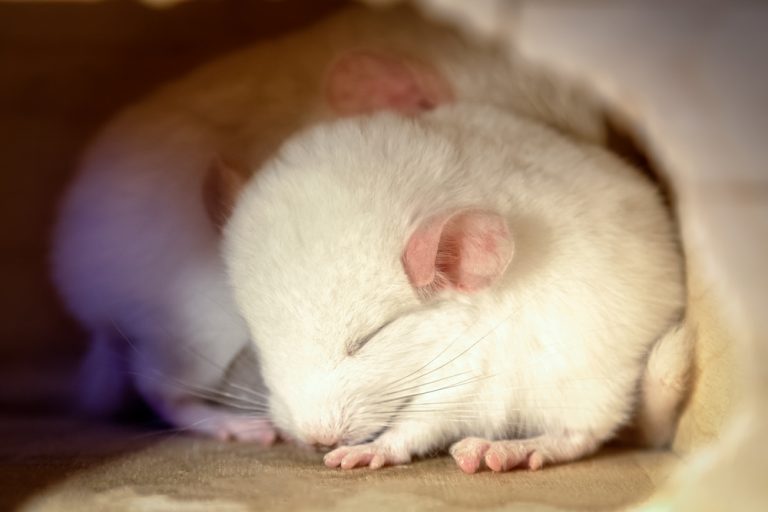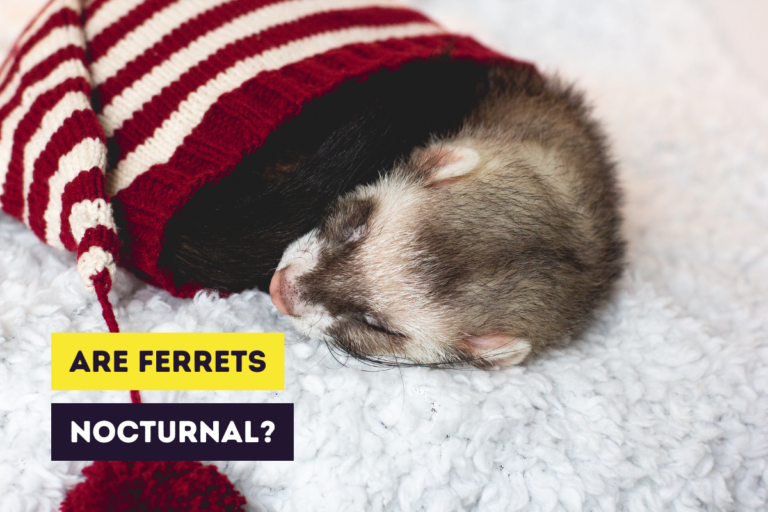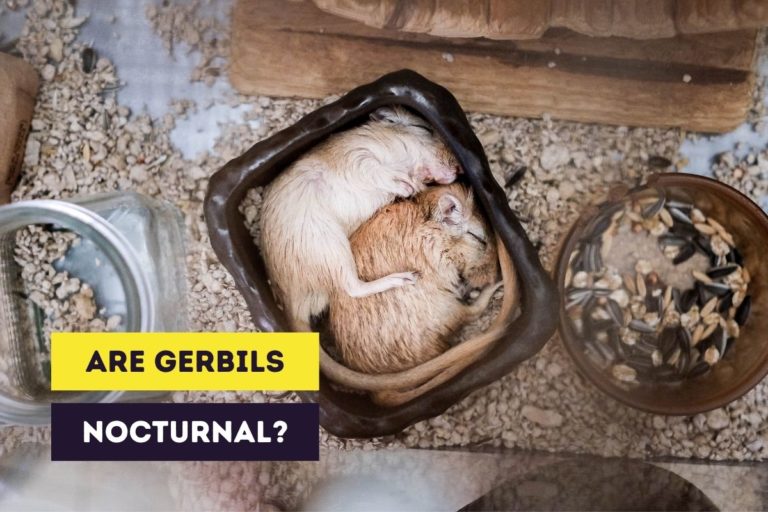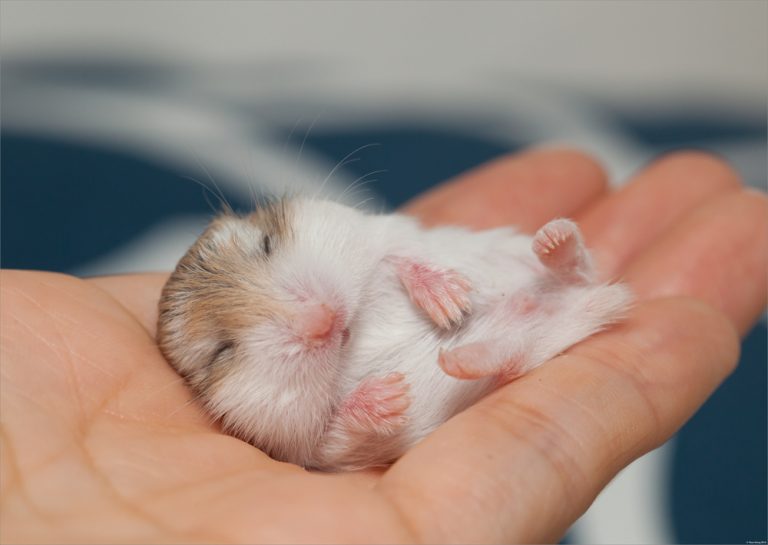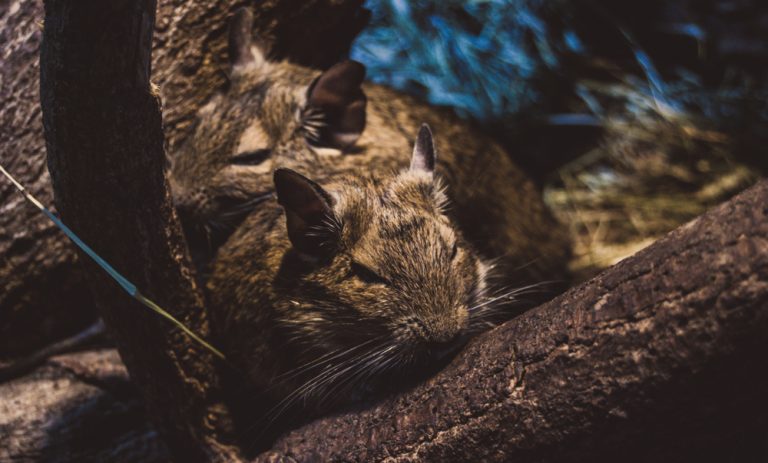The Sleeping Habits of Sugar Gliders: Are Sugar Gliders Nocturnal?
Sugar gliders are cute and active creatures and are a real “pocket pet” in the sense that they’re often held in bonding pouches during the day. Although sugar gliders are high maintenance pets that are not suitable for 99% of people around, they might be the perfect pet for you! When you’re choosing a pet you’ve got to consider if it’s suitable for your lifestyle. One of the important aspects to consider is whether or not your potential pet is nocturnal or not.
If you have a busy schedule during the day you won’t mind having a nocturnal or crepuscular pet. But if you need a good night’s sleep or don’t have time in the evening to play and take care of your pet, a pet that’s diurnal, which means active during the day, is more suitable.
Are sugar gliders nocturnal? Sugar gliders are nocturnal, which means that they are more active during the night. They will sleep during the day and will wake up at night. This makes them comparable with most other pocket pets. A lot of people keep their sugar gliders near their body in a sleeping pouch during the day.
In the wild, sugar gliders are usually found near trees where they sleep in their nests all day. They come out to explore at night, energetically cavorting from branch to branch in the canopy at the top of the forest. During the night time, they feed, socialize and explore under the safe cover of darkness. But what about keeping a sugar glider in captivity? How do sugar gliders fit in a “human” – diurnal – lifestyle?
In this article you’ll be learning everything there is to know about the sleeping habits of sugar gliders. I’ll also give you some tips and tricks to not disturb your sugar glider while it’s sleeping.
This site contains affiliate links to products we recommend and use ourselves. We may receive a commission for purchases that you make through these links. If you’re interested in learning more about our affiliate links, please visit our (affiliate) disclaimer.
Why Are Sugar Gliders Nocturnal?
Sugar gliders will sleep during the day and will become active during the night. During the night time, they feed, socialize and explore under the safe cover of darkness where they are less visible to potential birds of prey that could swoop down and snatch them away. It’s also one of the reasons why their eyes are so large, one of the things that make them look so adorable.
But why is a sugar glider nocturnal?
If you don’t know a lot about the sleeping habits of animals, let me give you an intro. There are a lot of different sleeping patterns but basically a pet can show diurnal, nocturnal or crepuscular behavior:
- diurnal: active during the day, for example, humans
- crepuscular: active at twilight, for example, the crested gecko
- nocturnal: active during the night, for example, owls
The sleeping behavior of an animal depends on a number of factors but the most important ones are the environment of the animal and their status as predator or prey animal.
Environment of sugar gliders
A lot of animals adapt their sleeping behavior to their environment and its climate.
In hot climates, an animal will often sleep during the day to conserve energy. At twilight or during the night they’ll become active and look for food. In cooler climates, most animals will be active during the day and will sleep at night.
Sugar gliders originate from Australia, New Guinea, and Indonesia. Their natural habitat consists of forests and sugar gliders are considered to be an arboreal species. The temperatures in their natural environment vary from very hot during the day to room temperature at night. Sugar gliders don’t like cold temperatures and will enter torpor (a kind of short hibernation) if it gets too cold.
Sugar gliders can tolerate high temperatures but are happiest at normal room temperatures. In their natural habitat, this kind of temperature will occur at night. At these times it’s not too hot and not too cold for the sugar gliders.
Sugar gliders are prey animals
Predators and prey adapt their sleeping habits to each other. Predators will be awake at times when they’re prey is available. Prey, on the other hand, will try to avoid the times when their primary predators are out hunting.
Sugar gliders aren’t predatory in nature and are a so-called prey animal. Their main predators are owls, kookaburras, feral cats, snakes and lizards, quolls, mulgaras, antechinuses and foxes.
Most of their predators are nocturnal and will stay in their burrows or nests during the day. Sugar gliders are out at the same time their predators are which is generally not a very good idea. The sugar glider does have the benefit of gliding from tree to tree so it can avoid contact with predators.
What Are the Consequences of Being Nocturnal?
There are some consequences of the nocturnal behavior of sugar gliders. It’s important to be aware of these consequences:
- sugar gliders will be awake during the night, might make noise and disturb your sleep
- they sleep almost the entire day, so they won’t miss you during the day
For most people, this will be no problem. If you’re at for work or school during the day your sugar gliders will be sleeping. When you come home in the evening your sugar gliders will be (almost) waking up. You should spend a lot of time bonding with your sugar gliders, by playing or cuddling with them.
The nocturnal nature of the sugar glider also has its possible downsides:
- cage location is important: the cage should be placed in a location that experiences a normal day/night light cycle. The cage should be in a location that has full daylight during the day and has no or very little light during the night.
- prevent boredom: sugar gliders can get bored if they’ve got nothing to do. Since they’re awake most of the night, it’s extremely important to provide enough cage space and toys for your gliders to be active and play. You’ll probably won’t be awake the entire night so it’s important to get at least a pair of sugar gliders. Sugar gliders are social animals that love the companionship of other sugar gliders. Also, make sure to spend each day playing and bonding with your little pets.
Sugar Glider Sleeping Habits
How long do sugar gliders sleep?
A sugar glider will usually sleep about 12 hours during the day and will wake up a few hours after dusk and stay up until dawn or early morning. Some sugar gliders will sleep a little more or less. Just as is the case with other animals, not all sugar gliders are the same and their sleeping habits might differ.
Where do your sugar gliders sleep?
In short, they sleep anywhere! In the wild, sugar gliders are happiest curled up in their nests and wrapped up with their families. They enjoy the warmth created by other bodies, and they prefer small spaces so that they feel comfortably enclosed.
At home, sugar gliders are more than happy to recreate their nests in their enclosures. As they like to line their nests with twigs, leaves, and soft feathers, you should try to provide them with some equipment that they can use to create the same effects. For example, small scraps of material and some strips of a newspaper can make a lovely soft nest, and some wool will add warmth and comfort.
Ideally, the company of another sugar glider will make them feel most content. They also enjoy the feeling of closeness when next to their family members and will feel happy curled up in your pocket or in a pouch around your neck where they can feel safe. Feeling the warmth, and heartbeat, of a family member, whether human or another glider, makes them feel most comfortable.
A good enclosure will have space for a specific nest box, possibly kept on a higher level to the rest. Ideally, there should be a small hole to allow the glider to enter and no other opening so the glider will feel safe as it sleeps. Once filled with bedding material, the glider can create a perfect little boudoir, safe from prying eyes or potential threats. Of course, the top could be removable to help you when cleaning the cage.
Sleeping pouches
While a homemade nest is perfectly serviceable, you could invest in a sleep capsule to give your glider a little extra luxury. These are pouches that come in a range of designs to make your sugar glider’s sleeping quarters look like a room at the Ritz! You can even change the pattern to suit the time of year, with some special Christmas bedding available.
Placing these pouches inside the nest is a little like giving the sugar glider their very own bed. The pouches are designed to fit snugly around the sugar glider so it is completely encapsulated, just like the feeling they have when intertwined with a whole family of sugar gliders in the wild. They are made from safe materials that are also very warm and cozy, like a duvet for your sugar glider.
Warmth is important for a good night’s sleep for your glider, as they originate from hot countries such as Australia and Indonesia. It is important to recreate sleeping conditions as close as possible to those experienced in the wild, both to make your sugar glider feel comfortable and also to ensure they have a healthy amount of sleep.
Changing sleeping habits?
While sugar gliders make loving and adorable pets, they can be grumpy or frightened if woken up unexpectedly. You may feel frustrated when you are home and ready to play while your sugar glider is still snoozing, but forcing them to wake up is not a good idea. They may bite when they feel threatened or upset. Over time, your glider will begin to get used to your routines. The inevitable noise when you first come home will be a trigger to your glider that it is time to wake up and play.
Once they have bonded with you, your sugar glider will want nothing more than to spend time with you so they will be glad to hear that you are home. They can be noisier than you think and might call for you, looking forward to getting out of their cage and spending time with their favorite person.
There are some methods you can employ to encourage your glider to wake up earlier. Ideally, their cage should be kept in view of natural sunlight: once it gets dark, your sugar glider will wake. You could manipulate this by keeping a light on next to their cage when you want them to sleep and turning it off to trigger a sense of darkness that will help them to wake up. Blackout curtains are another way to convince your sugar glider that the sun has gone and it is time to wake up. Placing food in their cage is also a good way to encourage them to wake up if needed.
Tips and Tricks
A healthy sugar glider needs its sleep and it’s important that you don’t bother them too much their sleep. To help you give your little pet the best sleep, here are some tips and tricks.
- make sure that the cage has at least one nesting box to sleep in
- make sure that the cage is in a room that experiences normal day/night light cycle
- feed your sugar glider in the evening
- don’t put the cage near a window or direct sunlight, this may cause overheating of the cage fast and the light may cause harm to the sensitive eyes of your sugar glider
Related Questions
Do sugar gliders sleep all day?
Sugar gliders are nocturnal and will sleep during the day. A sugar glider will usually sleep about 12 hours during the day and will wake up a few hours after dusk and stay up until dawn or early morning. Not all sugar gliders will spend the day sleeping and a lot depends on the habits you create.
Are sugar gliders loud at night?
Sugar gliders can make all kinds of barking noises during the night but they can also make noises when using their toys during the night. Make sure that you keep the cage outside of your bedroom so you won’t be disturbed in your sleep.
What do sugar gliders do at night?
In the wild, sugar gliders will feed, socialize and explore their territory during the night. In captivity, they will also feed and socialize with their fellow gliders. They will also play with their toys and explore their cage. Make sure that the cage is large enough and that you provide enough toys to keep your gliders busy during the night.
Why do sugar gliders bark during the night?
Sugar gliders are social animals and will communicate with each other through various noises. These vocalizations sound like barks and are entirely normal. It’s a way to socialize and might disturb your sleep if you keep your sugar gliders near your bedroom. So, be aware of this behavior and take precautions if necessary.

